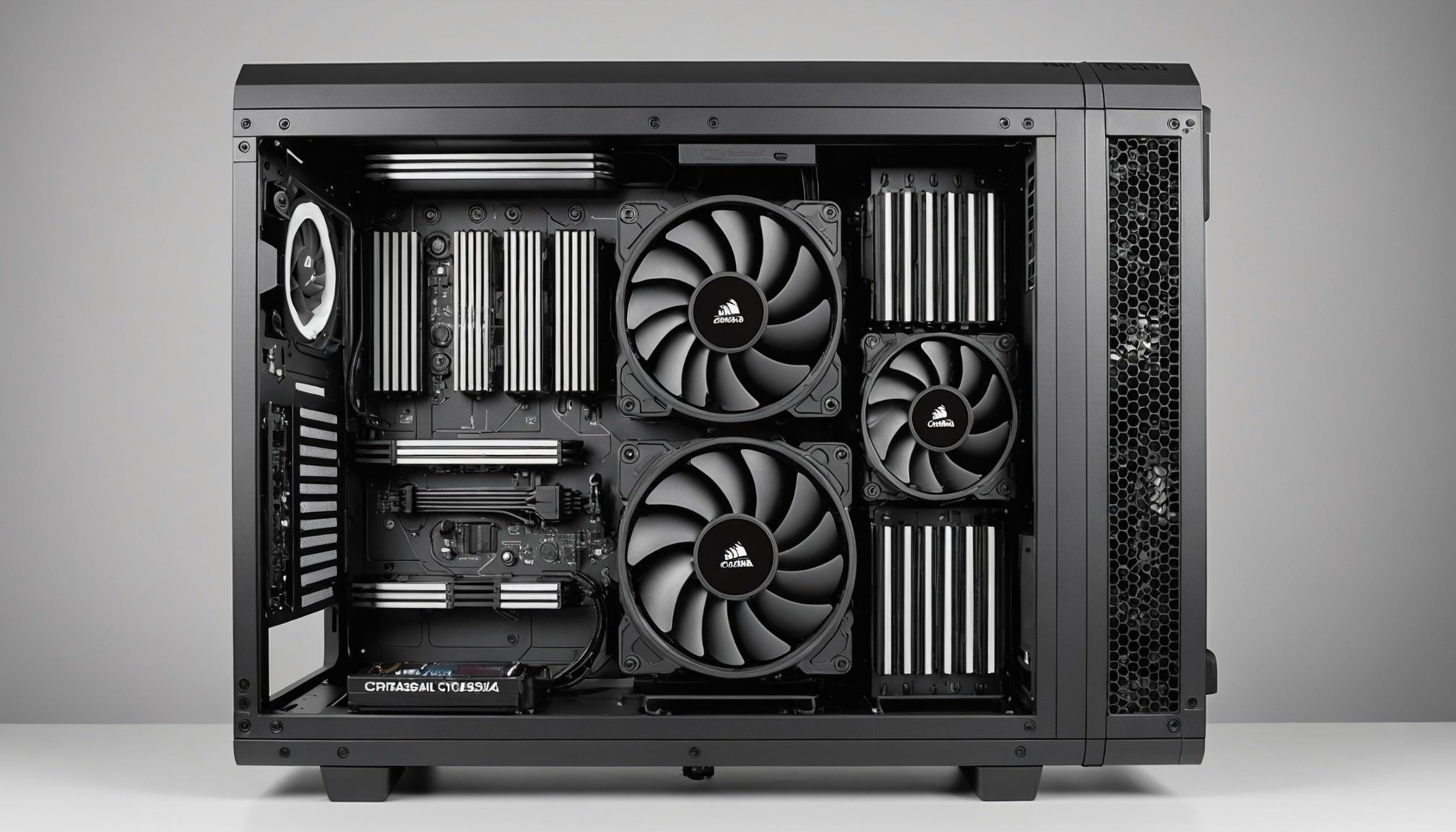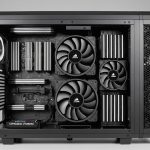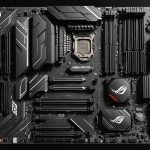Understanding Airflow Dynamics in the Corsair Crystal Series 680X
When considering airflow in the Corsair 680X, airflow optimization plays a crucial role. It is important to understand the dynamics involved to maximise cooling efficiency. Key to this is deciding between positive vs. negative pressure setups. Positive pressure is achieved when more air is pushed into the case than out. This tends to prevent dust from entering, while negative pressure does the opposite, potentially drawing in dust but ensuring a steady airflow across components.
Another factor influencing cooling is ambient temperature. Higher temperatures can reduce the cooling efficiency since the air being used to cool components is already warm. Therefore, monitoring and managing this can significantly enhance the system’s overall performance.
This might interest you : Master Your Gameplay: Crafting a Top-Tier Gaming PC with Intel Core i7-11700K, NVIDIA RTX 3070, and Lian Li PC-O11 Dynamic Elegance
In dual GPU cooling, air must be directed effectively around both units to prevent overheating. Ensuring that both GPUs receive adequate airflow without one blocking the other is vital for maintaining thermal efficiency.
Considering these factors will allow users to configure their systems for optimal cooling, regardless of their gaming or computing needs. By strategically planning airflow, case pressure, and accounting for environmental conditions, users can make informed decisions to keep the Corsair 680X performing at its best.
In the same genre : Enhance Your Home Network Security: Pro Strategies for Optimizing the Netgear Orbi RBK50 Mesh System
Ideal Fan Configuration for Enhanced Cooling
A well-planned cooling strategy is pivotal for the Corsair 680X. The foundation of robust thermal management lies in smarter fan placement. Understanding the roles of front, top, and rear fans can significantly enhance airflow optimization.
Front Intake Fans
Front intake fans serve as the primary source of fresh air. In the 680X, positioning these fans to pull in the maximum volume of air is crucial. Typically, using large, lower RPM fans helps reduce noise while maintaining effective cooling. Most users find that a combination of two or three 140mm fans at the front provides a good balance. Fan speed settings can be adjusted depending on environmental conditions or system load, ensuring efficient airflow into the case.
Top Exhaust Fans
Top exhaust fans play the role of drawing out hot air, maintaining a consistent outflow. Equipping the top panel with 120mm or 140mm fans offers effective removal of rising warm air. Balancing these fans with the intake system is essential to avoid creating inappropriate pressure differentials. Suitable configurations also include aftermarket fans, keeping them compatible with the Corsair 680X’s dimensions for ease of installation.
Rear Exhaust Fans
The singular rear fan ensures hot air is expelled swiftly from the back. A consistent low to medium speed setting is beneficial for unclogged airflow, complementing the other fans.
Maintenance Tips for Sustained Performance
Maintaining your Corsair 680X in prime condition necessitates regular upkeep. Proper maintenance tips can markedly enhance your system’s longevity and cooling performance.
Cleaning the Interior and Fans
Regularly cleaning the interior and fans is vital. Dust buildup can significantly impair airflow, leading to increased temperatures. Tools such as compressed air can be used to blow out dust from fans and components efficiently. For more stubborn grime, consider using a soft brush or a microfibre cloth.
Monitoring Temperatures and Performance
Consistently monitor temperatures to ensure your cooling setup operates effectively. Utilising software that provides real-time performance and thermal readings can help keep track of any anomalies. Taking immediate action on abnormalities can prevent potential damage to components.
Frequency of Maintenance Tasks
Establishing an appropriate frequency for these tasks is essential. Dust management should be performed every few months for general use, but more frequently if your environment is dust-prone. Regular assessments of airflow optimization can prevent hindrances in system performance. Developing a maintenance routine eases the burden of these tasks, ensuring the Corsair 680X sustains its high-performance standards.
Component Arrangement for Maximum Efficiency
When aiming for optimal thermal efficiency in the Corsair 680X, the strategic GPU positioning and thoughtful component layout are vital. Ensuring adequate spacing between GPUs helps prevent overheating, particularly in dual GPU setups. Each GPU requires sufficient airflow to maintain performance and avoid thermal throttling.
A clean and organized cable management system can substantially enhance airflow within the case. Proper routing of cables not only contributes to a tidy appearance but also minimizes airflow obstruction. This is key to ensuring all components receive ample cooling.
When arranging other components, it’s crucial to avoid placing obstructive elements in airflow pathways. For instance, large hard drive cages can block airflow, so they should be positioned carefully or even removed if not needed. Consider leaving space around heat-sensitive components to promote better air circulation.
Additionally, the use of riser cables can aid in positioning GPUs more flexibly if space becomes a concern. This facilitates a unique arrangement that can prioritize cooling efficiency, helping maintain a stable environment for high-performance demands.
Compatibility Considerations for Dual GPU Setups
Dual GPU compatibility in the Corsair 680X demands a thorough understanding of Corsair 680X specs. Ensuring that your GPUs physically fit within the case is essential. The case supports full-sized GPUs, but users must consider the impact of PCIe slot arrangement on airflow. A tight fit can obstruct airflow, leading to insufficient cooling and thermal management challenges.
Selecting GPUs that align with the dimensions of the case is a priority. Power requirements of the GPUs also play a significant role. Consider the thermal design power (TDP) rating; GPUs with lower TDP generate less heat, facilitating easier cooling. For recommended cooling solutions, employing aftermarket fans or liquid cooling systems can maintain a stable temperature in dual setups.
When positioning GPUs, ensure spacing allows for adequate airflow. Even slight adjustments in orientation can significantly influence airflow and cooling efficacy. This mitigates heat buildup and supports sustained performance. Overall, thoughtful consideration of these factors can lead to a setup that maximizes both performance and longevity in dual GPU configurations.
Performance Benchmarks and Results
A thorough understanding of performance benchmarks is essential for evaluating the cooling efficacy of the Corsair 680X case. When testing for thermals comparison, consistent scenarios must be selected to ensure accurate results across various configurations and environments.
Testing Methodology
The methodology involves establishing a baseline to compare the impact of different setups on cooling performance. Tests should simulate typical usage conditions, utilizing stress tests to push the system to its thermal limits. Measuring equipment should be positioned to accurately capture temperature variations within the case, particularly around thermal hotspots like GPUs.
Benchmarking Results
Initial findings indicate that an efficiently managed cooling system results in significant thermal reductions. By employing strategic configurations, users observed lower temperatures, particularly with optimized fan placement and effective airflow optimization. The balance between intake and exhaust pathways proved crucial.
Analysis of Cooling Performance
Understanding the cooling results provides users with insights into achieving optimal cooling performance. Real-world scenarios showed that fine-tuning aspects like fan speed and component layout can lead to notable performance gains. Users can replicate similar setups for efficiency, ensuring their systems meet the demanding thermal requirements of modern computing tasks.







